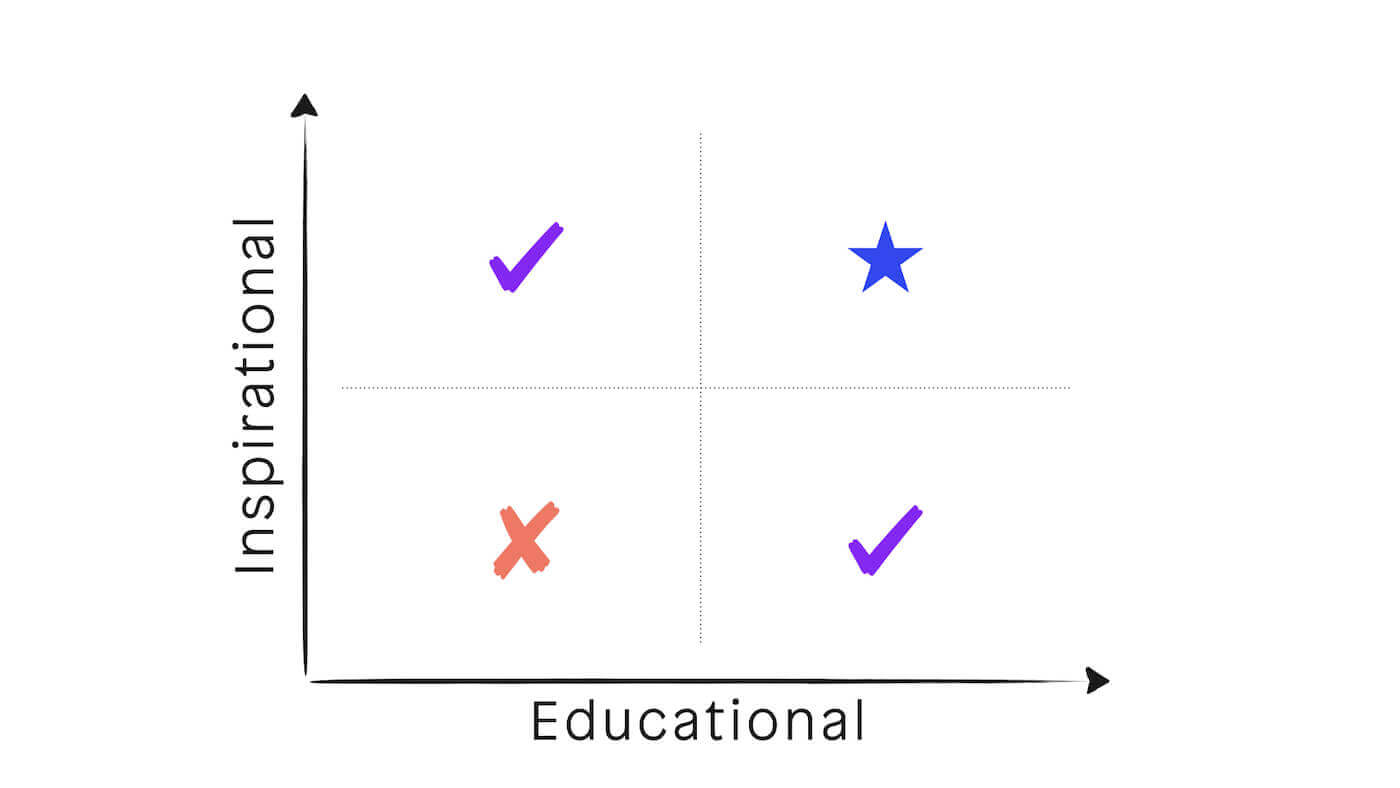There’s a lot of content and advice about giving presentations out there. Some of it’s really useful, some of it not at all.
Intercom has been holding events for years now, from large scale World Tours to more intimate Building Intercom events, with our founders, leaders and teammates delivering acclaimed talks on everything from building software to scaling your customer support team.
For almost as long, I’ve been working behind the scenes, helping colleagues hone their material and practice their delivery.
This is my attempt to distill everything I’ve learned down to a few key areas in an organized and useful way. Hopefully, you’ll find tips on public speaking you won’t see elsewhere and discover inspirational resources along the way.
Why are talks important?
Talks serve many practical purposes. They are important for promoting the ideas behind a company or making a pitch for capital. Content can be – and I would argue should be – a core component of your marketing strategy and can serve as a growth engine for your business. Like any other type of content, talks are a key tool in communicating who you are and what you’re about, as well as articulating what your company does and why. In particular, they help you connect with the community, build personal relationships with folks in relevant industries and share knowledge with other people.
“If you pay attention to each of these steps, you’ll be well on your way to having a great presentation”
Writing a good talk involves three key stages: before writing, while writing and after writing, each with their own important steps. I break these stages down into 10 key areas:
Before writing
1. Getting started
2. Inspiration
3. Ideation
While writing
4. Drafting
5. Preparing your slides
6. Adding richness to slides and content
After writing
7. Dry runs
8. Rehearsing
9. Stage presence
10. Iteration
Obviously, these steps can overlap – you may still be drafting pieces of your talk during a dry run, for example (it happens). But if you pay attention to each of these steps, you’ll be well on your way to having a great presentation.
Before you write your talk
One of the biggest questions I get asked is, “What do I write about?” The cliched answer is to write what you know, but I suggest starting from a different place.
1. How to get started
When you’re getting started with public speaking, you should always begin with your audience. If you don’t have one yet, start by writing your content for people like you and start by expecting your audience to be small. Many people want to jump straight into the conference circuit or are waiting for someone to recommend them to speak on the conference circuit.
“No one starts on the big stage, we all start in a small room with just a few people listening (maybe)”
You don’t have to wait, and you don’t have to speak at a conference to get started. They can be good forcing functions, but you don’t need them to begin to find your audience. Look for meetups and other easy, low effort ways like blogging to begin to build your content and work your way up. Start with a cupcake, and build up your content to the birthday cake. No one starts on the big stage, we all start in a small room with just a few people listening (maybe).
2. Finding inspiration
You should draw inspiration from a variety of sources. Always be on the lookout for speaking styles you like. Draw from comedy, politics, Ted talks, podcasts, TV shows and movies. Check out industries other than the one you’re in. What are they doing?
Find people you adore. Pay attention to what works, what doesn’t work, what they do say and what they don’t. Adapt what you learn to your personality. You’re not going to be Michelle Obama, but if you admire her inspirational speaking style, figure out what makes her inspirational. How does she talk about her ideas? This is something you can learn from and mimic.
3. Ideation
Sometimes the most difficult thing to do is figure out what to talk about and how to talk about it. Where should you start building content from?
It helps to think first and foremost about your audience:
- Always, always, always start with your audience. Who are they? Tailor your content to whom you are speaking.
- How many of them will there be? Smaller audiences and more intimate venues mean you can seek opinion from your audience and get them involved. With larger audiences, the effect of group dynamics will be different. You’re more likely to get people to laugh or clap for longer and louder.
- What does your audience want to know? The audience is coming to hear something, so try to figure out what that thing is. Take cues from the event name, the stage name (if applicable) and the theme (of either the event or stage).
- What do you want your audience to know? This should really be distilled down to one thing and one thing only. If your audience only takes one thing away from your talk, what should it be?
One way to help define your talk is to decide how inspirational or educational you want it to be. In the tech industry, there’s a lot of educational talks, but don’t forget that there are other ways to give great talks. You can map this out on a grid, like so:

The worst talks are neither educational nor inspirational. Symptoms will often include an over-reliance on text, hard to follow next steps and normally no overarching point.
Educational talks will have lots of actionable advice for the audience, but are often prone to focusing on the how and not the why. That said, the best examples can leave an audience feeling deeply informed – Des’s “Lessons learned from scaling a team” is an excellent example of a largely educational talk.
“The best talks are a mixture of educational and inspirational, big picture concepts and micro examples”
Inspirational talks will have lots of big picture: “Here’s a struggle that I overcame, you can do it too!” You’ll often leave feeling inspired and motivated, but may not necessarily know how to direct that energy. The most famous Ted Talks are usually great examples. One of my favorite mainly inspirational talks is Wilson Milner’s “When we build.”
The best talks are a mixture of educational and inspirational, big picture concepts and micro examples that all weave together to form the narrative tapestry. Amy Cuddy’s “Your body language may shape who you are” does a great job at this.
It’s important to note that it can take years to get to this point. Think big, start small.
As you write your talk
As you write, remember that your talk is not about you. It’s about your audience. It’s about how they want to feel and what they want to get out of your talk. If you can connect to that, people will love it.
Good talks are not about that time you built a cool new tool in your job. They are about what your audience can learn from that time you built that cool new tool. Every story you tell should connect to either what the audience wants to feel or something they can learn from. This is the perspective you should have as you write.
4. Drafting your talk
For a while before you give your talk, keep track of the things you want to say. Bookmark things you want to include like tweets and other artefacts. Once you’ve got some good ideas, then you can begin to pick out a structure. The most common is a three-act style, with an introduction, body and conclusion.
The second act will constitute the bulk of the material, so distill your ideas down to three main points. Less than three seems incomplete, and more than three is harder to remember. A good way to visualize your three main points is to write them out on a triangle.
As for the introduction and conclusion, write those last.
- The purpose of the introduction is to set up the talk. It answers the question: “What are the audience here to discover?”, and it also works to establish your credibility. Make sure you cover your thesis in the intro. What’s that one thing you want your audience to take away from your talk.
- Conclusions can be written to suit the venue. Are you handing off to someone else? Try linking their talk to yours. Are you speaking at a conference? Thank the conference and the audience for their time and attention. The conclusion should also remind everyone of that one thing again.
If you put this down on paper (your introduction, 3 points and conclusion), you will see your idea taking the shape of a traditional story arc. You don’t need to reinvent the wheel – there are a number of narrative structures that can help convey your points.

5. Preparing your slides – prioritize the basics
Most people think preparing a talk is all about doing slides. But that’s fundamentally wrong – the phase where you translate your draft into a presentation in Keynote or PowerPoint is actually a crucial moment where the core of your message gets refined and distilled, and thus you need to focus not on transitions or animations, but on paring the essence of your message into slide form.
This step is about getting the bare minimum amount of material in the presentation so you can go on stage, but remember that slides exist only to serve your narrative; they are one prop among many.
Whether you’re using Keynote, PowerPoint or (oh no!) Google Slides, bear these basic rules in mind so as to help you focus on what really matters.
- My number one tip for slides is no white backgrounds. Please, I beg you. They’re blinding when projected on a large screen on stage. While there is some debate around this, it’s generally easier for people to focus on lighter text on a dark background than darker text on a light background. Stark black (#000000) is always best avoided completely.
- Keep your text-based slides succinct. Paul Adam’s slides from The end of navel gazing do this well. They distill the main ideas down to the very basics and keep the focus on what Paul is saying. Audiences easily tune out, so the purpose of props such as slides is to help them tune back in. A useful guideline is 4×4: no more than 4 words per line, and no more than 4 lines.
- Keep fonts simple, yet appropriate for the content. Sans serif fonts are the most common for a reason, but you can try swapping Helvetica or Arial for another font like Gill Sans, Futura or Avenir to help the slides look more polished. Above all, consider legibility – many handwriting fonts can be difficult to parse.
6. Adding richness to your slides and content
Less is more when it comes to your slides, and it’s far more important to focus on getting the basics of the narrative and presentation just right. Once you’re confident you’re reached that point, there are a few things to consider to add richness to your slides and content.
Animation in any presentation can be easily overdone. Any animation should always serve a purpose. Interaction designer Kit Oliynyk breaks down his guiding principles of UI animation here and sorts animations into the following categories, which apply to presentation animation as well:
- Functional animations can improve audience comprehension, drive audience attention, delay information until the correct moment and demonstrate a change or evolution in something.
- Material animations incorporate things like gravity, inertia, velocity and rigidity so that they appear more authentic and less cheesy or “wrong.”
- Delightful animations introduce spontaneity and that feeling of uniqueness and of being human. Attention to detail won’t go under-appreciated.
Another way to make your content feel richer and more relevant is to incorporate something topical. Consider referencing other aspects of the conference or timely events:
- Who else is speaking? What are they talking about? Can you relate it to what you’re saying? You have the benefit that the event is a shared experience, and you can use that to improve your talk for the audience. At Intercom, we often run events and every speaker will mention at least one other speaker. This brings both continuity and logic to what you’re saying.
- What happened today, this week or this month that relates in some way to your talk? What’s the latest pop culture phenomenon? Again, this is about cultivating a shared experience between you and your audience and leveraging pre-existing knowledge to connect with them.
After you write your talk
7. Dry runs: Practicing on your own
The best thing to do when practicing is to recreate the environment you’re going to be in as much as possible. Practicing in a small room, or in front of a mirror might seem like the right thing to do, but it’s better to find a space with a projector, get familiar with using a clicker and walking across a stage, even if it’s a makeshift one.
Your dry runs don’t have to be perfect. When you screw up, keep going. Build resilience. Things will go wrong in the actual presentation, so be prepared for that as much as possible.
“Practice everything from how you enter the stage all the way through to exiting the stage”
This is a good time to edit your content. It might be the first time you’re saying things aloud, and you’ll find that some things work and some really don’t.
I’d recommend at least two to three full dry runs on different days. Practice everything from how you enter the stage all the way through to exiting the stage. Thank whoever introduces you when you get on stage, and thank the audience for their time before you leave it.
To imagine your audience, place 5 post-it notes with smiley faces around the room, and as you’re practicing, try to make eye contact with your “audience.”
8. Rehearsals: Practicing with others
Most people know it’s important to seek feedback, especially when giving a public presentation. But who you seek feedback from matters just as much as asking for it. One of the biggest mistakes I see speakers make is to seek feedback from their team, or a group of people they work closely with every day.
Obviously, your team can be a good place to get feedback on the facts of your talk and to validate your ideas. Is what you’re saying factually correct? Are you making sense? These are good questions to ask your team.
However, you are much better off seeking feedback from people you know who are good speakers. Other talented speakers will be able to give you helpful feedback on how to present your ideas or reframe your stories to be more impactful in the context of a stage.
9. Improving your stage presence
When it comes to talks, everyone is nervous. You’ve probably heard this before, but it really is true. Seasoned speakers get nervous. Speaking coaches get nervous. Think of the best talk you’ve ever heard, and I guarantee you that person was likely nervous.
The only “speaking hack” you need to know is to increase the volume of your voice. Raising your voice has two distinct advantages:
- You sound clearer and more definitive to your audience.
- It gives an outlet for all that nervous energy: you fidget less, your arms find a more natural place, your stance relaxes and your posture gets better.
This adjustment is the #1 thing you can do to improve your stage presence almost immediately.
10. Iterating on your content
You should never give a talk just once. If you are giving your talk at an event, only the people viewing the event will have seen it. Most of the time that means you can bring your content elsewhere, and it will be viewed with fresh eyes, even if it’s not new to you.
Talks are really just conversations. While talks might seem like monologues or one-to-many broadcasts of ideas, that’s not entirely true. The very best talks generate conversation and / or participate in an existing conversation that’s already happening. These conversations can happen on Twitter and in real life after you finish speaking.
“Prepare ahead of time for luck to turn against you and adapt on the day”
You want people to respond to you, and you want as many people to respond to you as possible, even if they don’t agree with you, or especially if they don’t agree with you. This is where you can learn the most, and then refine your content. Use people’s responses to figure out what you should say next time. Encourage people to come talk to you and use what you’ve learned to refine your content. What worked? What didn’t work?
Now that you have a talk, it’s really easy to add new content in and remove outdated content, rather than writing a whole new talk. You can then give this new and improved version at other events and expose your ideas to new people.
A final thought: Murphy’s law
I want to leave you with one last thought, and that is about Murphy’s law. Sometimes, it feels like anything that can go wrong will go wrong. It absolutely applies to every conference, and just in the events I have worked on, all of these things have actually happened: the lighting guy had an off day and kept missing the speaker; another speaker got food poisoning; a presentation was prepared in Keynote, and the conference only used PowerPoint; the clicker malfunctioned. The list goes on and on.
Prepare ahead of time for luck to turn against you and adapt on the day.
As they say here in Ireland, you’ll be grand :) Good luck! 🍀
Because it’s impossible to cover everything I wanted to share some extra resources:
- David Nihill has a great book on public speaking techniques.
- Nancy Duarte runs a company that helps many well known companies in many industries give good presentations. If you’ve seen An Inconvenient Truth, you’ve seen her and her company’s work.
- Presentation Zen by Garr Reynolds is a top recommendation from Des Traynor for helping with talks.
- Lara Hogan used to work as an engineering leader at Etsy and Kickstarter and became so well known for good public speaking, she wrote a book on it.
Animation resources:
- Behance is a great source for professional and clean animations.
- Invision has a handbook on the principles of animation and a breakdown of animating designs in Keynote.
- Andrew Cohen also prototyped designs in Keynote.
